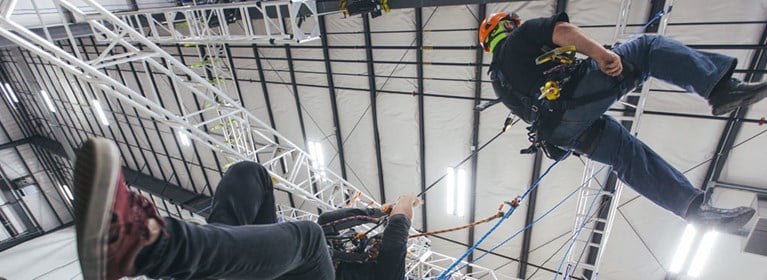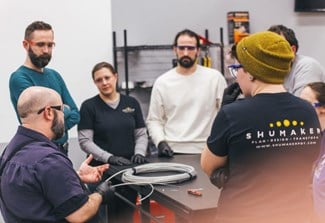
Gene, a CMCO distributor salesperson, writes:
“I am not seeing eye to eye with my customer on a bridge crane alarm issue. His claim is that the warning device must be an alarm (sound) and that it should be continuously on when the bridge is traveling. The standard he is referencing is ANSI B30.2 (1967) with the claim that it is incorporated by reference into law.
I have found numerous references myself to other standards regarding the requirement for a warning device. Where is the standard that permits a strobe? Where do you find the statement that makes ASME as the controlling entity? Thanks for your help!”
Our Columbus McKinnon Training Team replies:
For the short answer, please skip to the bottom of the page.
For the long, detailed answer, please read on:
To start out let’s determine if the crane in question is top running or underhung. If any load-bearing member of a crane or monorail travels on an internal or external lower flange or equivalent it does not fall within the purview of OSHA 1910.179. The Federal Occupational Safety and Health Administration has issued several interpretations stating as much. One such interpretation was issued to Mr. Thomas Hagerty, on March 4, 1991 in response to his question: Does this standard apply to under-hung cranes, hoists, and monorails? OSHA’s reply was, “This standard does not apply to under-hung cranes, overhead hoists, or monorails. Under-hung cranes and monorails are covered in ANSI B30.11-1980, a National Consensus Standard.”
ASME B30.11 states the requirement for a warning device but does not specify what type or how it should be used.
ASME B30.11 SECTION 11-1.11 WARNING DEVICES: “On cab- and remote-operated cranes or carriers, an audible or visual warning means shall be provided.”
ASME B30.11 is a consensus standard. It does not have the power of law. It may be used by OSHA to support a General Duty Clause violation, (5)(a)(1) to “demonstrate that a hazard and abatement options are recognized by industry.”
OSHA 1910.179 applies only if both the crane bridge and trolley are top running.
Paragraph 1910.179(b)(2) states, “All new overhead and gantry cranes constructed and installed on or after August 31, 1971 shall meet the design specifications of ANSI B30.2 (1967).” OSHA became law on August 31, 1971, for overhead and gantry cranes. Your distributor is correct in that OSHA 1910.179 “incorporates by reference” in CFR 29 1910.6, the B30.2 – 1967 standard.
OSHA 1910.179 does address the requirement for a warning device. This requirement is vague at best. “1910.179(i) Warning device; except for floor-operated cranes a gong or other effective warning signal shall be provided for each crane equipped with a power traveling mechanism.” (Note: Floor Operated Cranes are defined as Pendant Operated)
While I do not have access to the 1967 version of ASME / ANSI B30.2 1967, it is highly unlikely the standards have become less restrictive or less protective since 1967. The current ASME B30.2 – 2005 states the following requirements:
SECTION 2-1.15: WARNING DEVICES OR MEANS FOR A CRANE WITH A POWER TRAVELING MECHANISM
2-1.15.1 Cab- and Remote-Operated Cranes
(a) A warning device shall be provided.
(b) Refer to para. 2-3.1.7(e) for operation of the device.
2-1.15.2 Floor-Operated Cranes
(a) A warning device should be provided for installations where the ability of the operator to warn persons in the path of the load is impaired.
2-1.15.3 Types of Devices
One or more of the following devices shall be provided when required:
(a) manually operated gong
(b) power-operated bell, siren, or horn
(c) rotating beacon
(d) strobe
2-3.1.7 Conduct of Operators
(e) The operator shall activate the warning device on cab- and remote-operated cranes and, when provided, on floor-operated cranes
(1) before starting the bridge or trolley motion of the crane,
(2) intermittently during travel of the crane when approaching persons in the path of the load.
So… after a very long summary of the supporting standards and documentation, the answers to your questions are:
Question 1 – The allowance for the strobe is covered in ASME B30.2-1.15.3(d) above.
Question 2 – ASME is not law. ASME has no enforcement authority. BUT if the crane is not a top running bridge and top running trolley, only ASME B30.11 or 17 is applicable.
In closing: (A) The alarm does not need to run continuously and has been proven to be less effective if it does. (B) It also does not have to be a siren or audible device.
North America - EN






